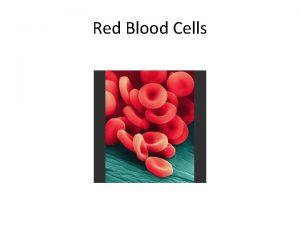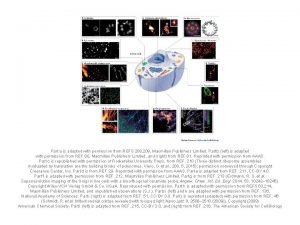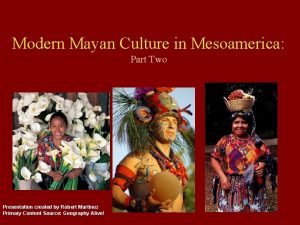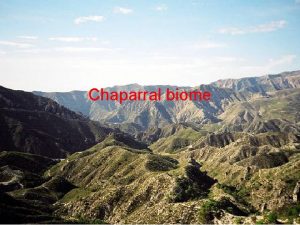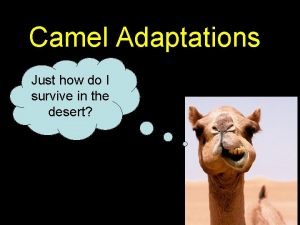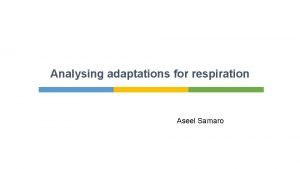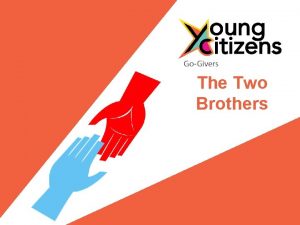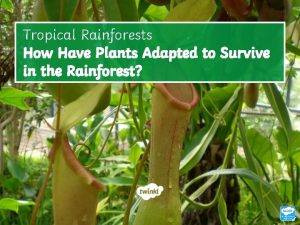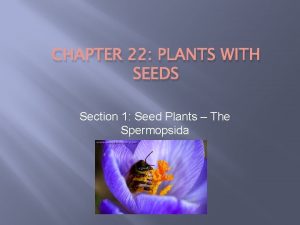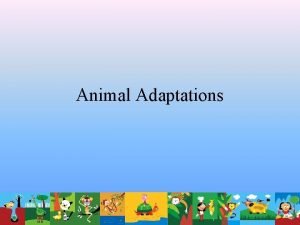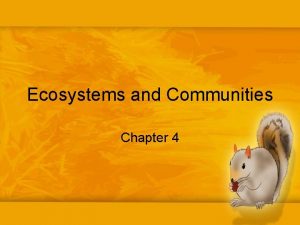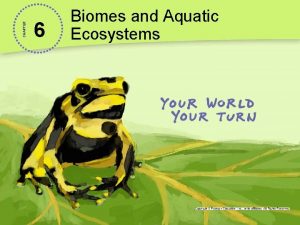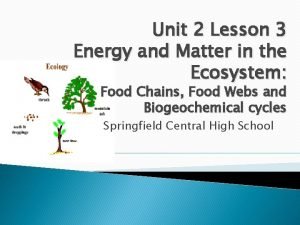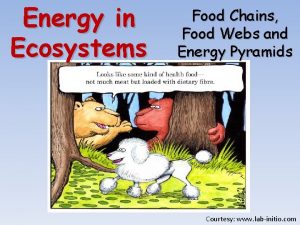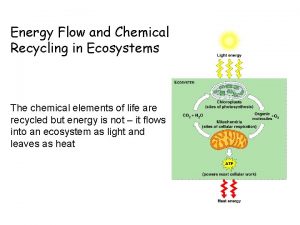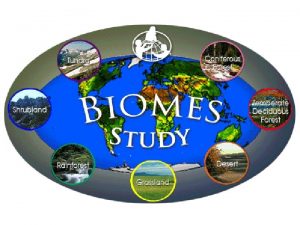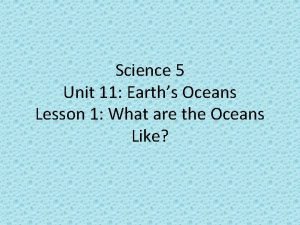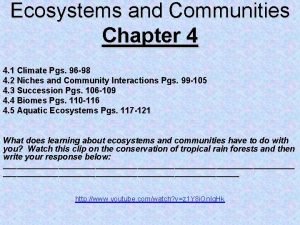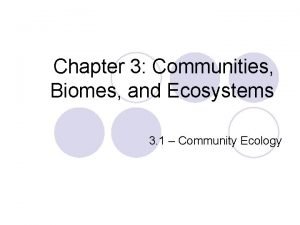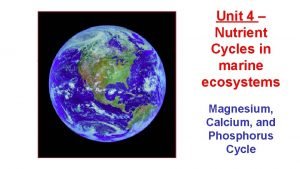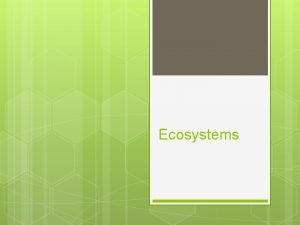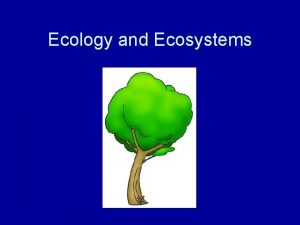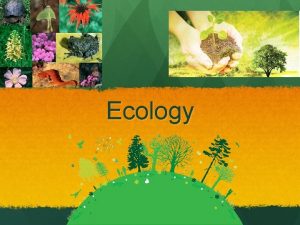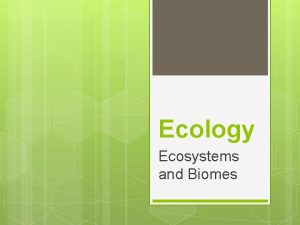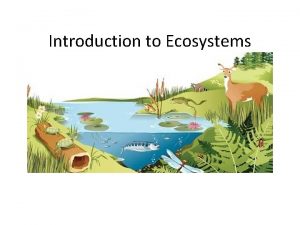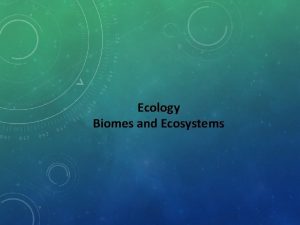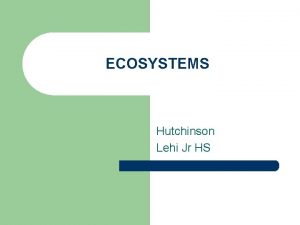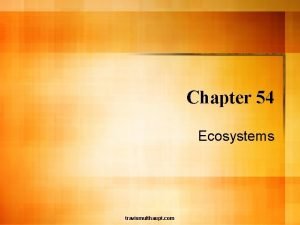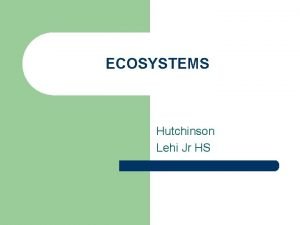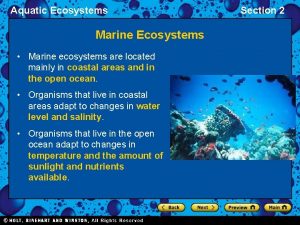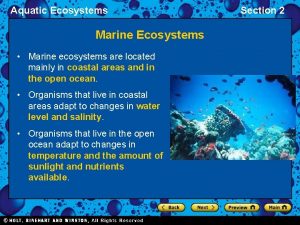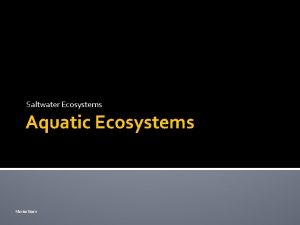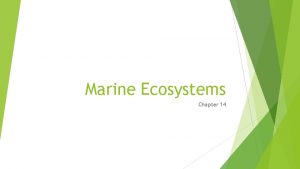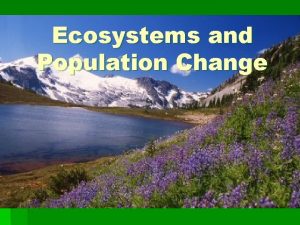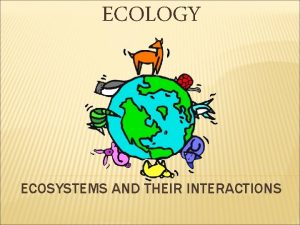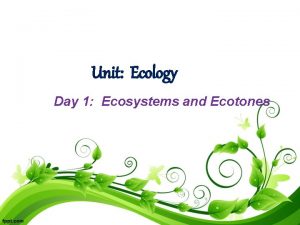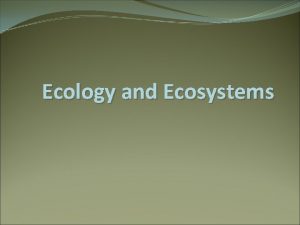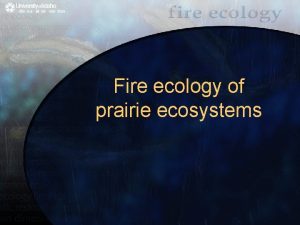Topic 2 Ecosystems and Ecology adapted from Mrs






































- Slides: 38

Topic 2 Ecosystems and Ecology adapted from Mrs. Kristen Page

• To use for an online lab simulation • http: //www. learner. org/courses/envsci/interactives/index. php

2. 1 Species and Populations

2. 1 SIGNIFICANT IDEAS: • A species interacts with its abiotic and biotic environment, and its niche is describe by these interactions. • Populations change and respond to interactions with the environment. • All systems have a carrying capacity for a given species.

APPLICATION & SKILLS • Interpret graphical representations or models of factors that affect an organism’s niche. Examples include predator-prey relationships, competition, and organisms abundance over time. • Explain population growth curves in terms of numbers and rates.

KNOWLEDGE & UNDERSTANDING • Define and Give Examples of the terms: species, habitat, niche, abiotic factors, population, limiting factors, carrying capacity • Distinguish between fundamental and realized niche. • Distinguish between S and J population curves and explain the factors that influence which type of population curve a named population would show. • Explain and give named examples of different population interactions including: competition (inter and intra-species), predation, parasitism, herbivory, and mutualism.

IB TESTING TIPS: • IB often asks for named examples, be sure to use specific examples and use specific names (scientific names are not required). • For example if you just say tiger this refers to 1 of 10 species versus Bengal tiger is specific to one region and one species! • For a named example of a habitat or ecosystem • be specific; The Giant Kelp Forest off the coast of Monterrey Bay California is much better than the beach • give as much detail as possible; The Sundarbans is the largest mangrove forest in Southern Bangladesh and South-eastern India.

What is an Ecology? § The study of the living and non-living parts that interact within an ecosystem.

How many of these terms do you know? • Organism • Species • Population • Community • Niche • Habitat In your notebook draw a bunch of little organisms. Some of the same type of some of different types. ▪ Label 1 individual as an organism. ▪ Label a group of the same type of organisms (species) ▪ Circle: individuals of the same species (Population) ▪ Draw interactions between the populations (Community)

Levels of Organization • Ecologists study several different levels of organization: • Species • Population • Community • Ecosystem • Biome • Biosphere

Species • a group of organisms that share common characteristics and that are able to reproduce and produce fertile offspring. • Humans, Giraffes, Pine Trees • Contains two parts: Genus species • Always underlined or in italics • Genus always capitalized & species all lower case • Examples: • Homo sapiens (humans) • Panthera tigeris (Bengal Tiger) • Sequoiadendron giganteum (Giant Redwood) • Bombus lucorum (white tailed bumblebee)

Naming Species

Populations • Population: A group of individuals of the same species living in the same area at the same time. • Able to interbreed • Snails in two different ponds may breed with only snails in each respective pond. • Populations can be separated by geography and eventually stop interbreeding • Form a new species this way.

Community • group of different populations that live in the same area

Ecosystem • A community of interdependent organisms and the interactions with the physical environment in which they live. • It can also be defined as the abiotic and biotic factors and the interactions between them. • The interaction between organisms and the environment is the key!

Biome § Group of ecosystems with similar climate and dominant communities Tropical rain forest Temperate grassland Temperate forest Tundra Tropical dry forest Desert Mountains and ice caps Tropical savanna Temperate woodland shrubland Northwestern coniferous forest Boreal forest (Taiga)

Biosphere • The biosphere refers to the portion of the planet in which all of life exists: • Land • Water • Air

Habitat vs. Niche • Habitat: where an organism lives • The habitat must provide a source of food, water and shelter for the organism. • Includes the abiotic and biotic factors • Niche: the role (“job”) of the organism. • This is largely to do with the trophic level of the organism (what it eats) and the particular set of abiotic and biotic conditions to which an organism responds • Example: Small fish in a coral reef share the same habitat, but each species has a different niche. Each population has a different “job” based on its shape, size, color, behavior, and feeding habits.

Abiotic vs. Biotic Factors §Biotic Factors: All the living components of an ecosystem § Example: plants, bacteria, fungi, animals §Abiotic Factors: non-living, physical factors in the ecosystem that may influence an organism or a system § Examples: Temperature, salinity, p. H, light,

Biotic or Abiotic? • River dolphin • Algae • Daylight hours • Precipitation • Moss • Soil composition • Mushroom • Rocks • Minerals • Mangrove trees • Swamp grass

Fundamental vs Realized Niche • No two species can have the same ecological niche in the same place at the same time! • Fundamental Niche: the entire range of conditions in which a species could live • Realized Niche: the actual conditions under which the species lives (usually due to competition)


Limiting Factors • Factors in an ecosystem that limit the population size if there are too much or too little of it. • Sunlight • Precipitation • Salinity • Nutrients in the soil • Food • Limiting factors cause a reduction in population growth as they become in short supply.

Limiting Factors can be density dependent or density independent 1. Density-dependent factors: • Will increase or decrease the carrying capacity of a population based on the SIZE of a population • Ex. amount of food available • Come up with 3 other density-dependent factors: Density dependent factors typically involve biotic factors, such as the availability of food, parasitism, predation, disease, and migration. As the population increases, food become scarce, infectious diseases can spread easily, and many of its members emigrate.

2. Density-independent factors: • Will increase or decrease the carrying capacity REGARDLESS OF THE SIZE of the population • Ex. a forest fire • Come up with 3 other density-independent factors: In ecology, density independent factors are the physical or abiotic factors like weather, forest fire, pollutant, etc.

Population Changes • Carrying Capacity (k) = The maximum number of organisms of a single species that an ecosystem can support • Population Dynamics: the study of the change in populations over time • We use population graphs to look at the changes in populations over time. • Sketch what a population growth curve would look like if there were no limiting factors.

Population Growth Curves • Without limiting factors, there will be exponential growth (there is nothing limiting population size) • Is this realistic for most populations? Justify your answer!

S-Curves Characteristics: • Start with exponential growth • Slow as they limiting factors become scarce • When population reaches carrying capacity (K) there is no longer growth • Where exponential growth slows until we reach carrying capacity is called environmental resistance Environmental resistance

S-Curves • In reality populations tend to fluctuate around the carrying capacity. • What type of feedback system is this an example of? • Negative Feedback

Region A • Slow rate of reproduction • Only a small number of organisms are sexually mature and able to reproduce A B • The organisms may be adjusting to a new environment. Region B • Many organisms have reached sexual maturity and are reproducing • The organisms have adjusted to their environment • The have ample food and water Region C • The carrying capacity has been reached • Population growth becomes constant. • The number of deaths equals the number of births C

K- and r-strategists: Reproductive strategies

K-Selected Species r-Selected Species • Have small numbers of offspring but invest large amounts of energy in parental care. • Most offspring survive, long lives • Examples? • Have extremely large numbers of offspring, but invest little or no time raising them. • Reproduce quickly, but short lived • Examples? • Humans • Large mammals • Good competitors and population is usually close to carrying capacity • Can outcompete r-strategists in good conditions • Invertebrates and fish • Usually exceed carrying capacity and populations collapse. • Colonize new habitats rapidly • Predominate in unstable ecosystems

• Do you think humans have or ever will reach carrying capacity? What evidence would support humans reaching carrying capacity? • …carrying capacity is determined jointly by human choices and natural constraints. Consequently, the question, how many people can the Earth support, does not have a single numerical answer, now or ever. Human choices about the Earth's human carrying capacity are constrained by facts of nature which we understand poorly. So any estimates of human carrying capacity are only conditional on future human choices and natural events. " - Joel Cohen

J-Curves Characteristics: • Show a boom and bust pattern • Population grows exponentially • Sudden collapse called a dieback • Often the population exceeds carrying capacity which is called overshoot • Typical of microbes, invertebrates, fish and small mammals • Can you think of any other populations that might show this type of curve?

What type of Population Growth?

What type of Population Growth?

Interactions Between Organisms • Through this activity you should learn about different types of interactions between organisms and how these interactions affect the populations dynamics of the organisms involved. • Relationships between Organisms Class Jigsaw Activity

Jigsaw activity vocabulary to know • Competition • Competitive exclusion • Intraspecific competition • Interspecific competition • Predation • Herbivory • Parasitism • Mutualism
 Phosphorus cycle pearson education
Phosphorus cycle pearson education Chapter 55 ecosystems and restoration ecology
Chapter 55 ecosystems and restoration ecology They are mrs garcia and mrs castro
They are mrs garcia and mrs castro They are mrs garcia and mrs castro
They are mrs garcia and mrs castro Mrs. darling was ___________ of mrs. s.
Mrs. darling was ___________ of mrs. s. Broad topic and specific topic examples
Broad topic and specific topic examples Narrowed down topic examples
Narrowed down topic examples This passage is adapted from jane austen
This passage is adapted from jane austen Erythroposis
Erythroposis Adapted with permission from
Adapted with permission from In what ways have the highland maya adapted to modern life?
In what ways have the highland maya adapted to modern life? Xerophytic adaptations
Xerophytic adaptations Climate of the chaparral biome
Climate of the chaparral biome Camel adaptations for survival
Camel adaptations for survival Adapted animals in the rainforest
Adapted animals in the rainforest Best brother quotes
Best brother quotes Adapted from the internet
Adapted from the internet Gallant
Gallant How have plants adapted to the rainforest
How have plants adapted to the rainforest How spermopsida adapted to life on land
How spermopsida adapted to life on land The outsiders adapted for struggling readers
The outsiders adapted for struggling readers Pattern synoynm
Pattern synoynm How are giraffes long necks adapted to their lifestyle
How are giraffes long necks adapted to their lifestyle Chapter 4 ecosystems and communities
Chapter 4 ecosystems and communities Chaparral biomes are generally _______.
Chaparral biomes are generally _______. Why biomes are important
Why biomes are important Chapter 42 ecosystems and energy
Chapter 42 ecosystems and energy Chapter 3 lesson 3 biomes and aquatic ecosystems
Chapter 3 lesson 3 biomes and aquatic ecosystems Frog life cycle
Frog life cycle Energy flow trophic levels
Energy flow trophic levels Phosphorus cycle
Phosphorus cycle Lab food chains and energy in ecosystems
Lab food chains and energy in ecosystems Motive force
Motive force Biomes and aquatic ecosystems
Biomes and aquatic ecosystems Section 3 water pollution answers
Section 3 water pollution answers Oceans map
Oceans map Chapter 4 ecosystems and communities
Chapter 4 ecosystems and communities Orderly natural changes and species replacements
Orderly natural changes and species replacements Marine magnesium cycle
Marine magnesium cycle








